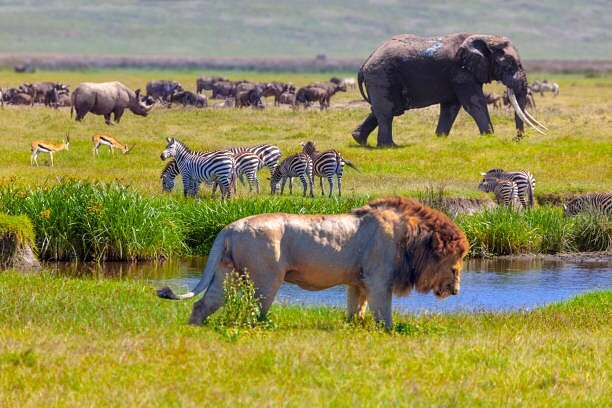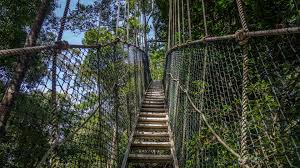Tanzania is full of adventure and warm hospitality. You’ll find amazing wildlife, beautiful beaches, friendly people, and rich cultures. From the great Serengeti and Mt Kilimanjaro to the lovely Zanzibar islands – Tanzania has it all in one exciting place.

The Serengeti is unforgettable for anyone who visits. It could be the view from Naabi Hill, where the vast grasslands seem endless, or spotting a group of lions crossing the plains. The annual migration of millions of animals also leaves a lasting impression, as they follow the seasons’ rhythms. Welcome to one of the best wildlife destinations in the world.
In the Serengeti, you’re surrounded by the beauty, power, and mystery of nature. Every year, hundreds of thousands of animals like wildebeests (around 1.5 million) move across the land searching for fresh grass. February is a special time, with over 8000 wildebeest calves born daily, though many don’t survive. Besides the wildebeest, you can spot resident animals year-round, and if you’re lucky, a few black rhinos in the Moru Kopjes area.
The 14,763-sq-km park is also home to predators, especially lions. You’ll find cheetahs, leopards, hyenas, and jackals hunting animals like zebras, giraffes, buffaloes, and gazelles. For birdwatchers, Serengeti is a paradise with over 500 species to see.
Entry tickets are valid for 24 hours and allow only a single entry.

Since its official opening in 1977, Mt Kilimanjaro National Park has become one of Tanzania’s most popular parks. Unlike the other northern parks, this park isn’t known for wildlife, though you will find some. Instead, it attracts visitors who want to marvel at a snow-covered mountain on the equator and climb Africa’s highest peak. The park is home to Mt Kilimanjaro, which stands at 5896m and is one of the most stunning sights in Africa.
Kilimanjaro is also one of the world’s highest volcanoes and the highest free-standing mountain on earth. It rises from farmland at the base, through lush rainforests, alpine meadows, and eventually to a lunar-like landscape with the twin summits of Kibo and Mawenzi. Shira, the third volcanic cone, is on the western side. The lower rainforest is home to animals like buffaloes, elephants, leopards, monkeys, and occasionally elands.
Each year, around 25,000 trekkers attempt the climb because it’s possible to reach the summit without needing technical climbing skills. But don’t be fooled; the climb is challenging and expensive, requiring proper preparation. The lower slopes of Kilimanjaro also offer great opportunities to explore and learn about the Maasai and Chagga tribes in the area.
There are various entry gates like Machame, Marangu (where the park headquarters is located), and Londorosi. If you are trekking the Rongai route, make sure to pay fees at the Marangu gate.

Empakaai Crater, located 23km northeast of Olmoti Crater, may not be as well-known as Ngorongoro, but many travellers consider it just as beautiful. The crater is filled with a lake that attracts flamingos and other waterbirds. The crater’s floor is mostly covered by the lake, and it is surrounded by steep, forested cliffs that rise at least 300m high. The view from the rim of the crater is one of the most stunning in northern Tanzania, and hiking down into the crater is an unforgettable experience.
The road from Ol Doinyo Lengai runs along the eastern rim of the crater, with altitudes ranging from 2700m to 3200m. A well-maintained, steep trail leads down through a montane forest that’s home to many bird species. You might also spot hyenas, buffaloes, blue monkeys, and even elephants. As you make your way to the crater floor, you’ll enjoy views of the turquoise lake and the perfect volcanic cone of Ol Doinyo Lengai to the northeast. It takes about 30 minutes to reach the lakeshore, and an hour to climb back up. If you want, you can walk around the lake, which will take at least four hours.
If you plan to hike, it’s required to pick up an armed ranger (US$23.60) from the Nainokanoka ranger post, located next to Olmoti Crater, on the way to Empakaai.
To reach the crater, expect a 90-minute drive from the Lemala ascent-descent road.

Welcome to one of Africa’s most underrated parks. Due to its close proximity to the Serengeti and Ngorongoro, Tarangire is often just a one-day stop in a larger northern circuit. But it deserves much more time, especially in the dry season. This is a place where elephants roam the plains like cattle, and where the sounds of lions roaring and zebras barking fill the night, all set against ever-changing landscapes.
Tarangire has the second-highest concentration of wildlife of any Tanzanian national park (after the Serengeti) and is said to have the largest concentration of elephants in the world. The park’s ecosystem, with Tarangire at its core, is home to more than 700 resident lions, and sightings are quite common. Less often seen, but still present, are leopards and cheetahs. These predators are supported by large herds of zebras, wildebeest, hartebeests, elands, oryx, waterbucks, lesser kudus, giraffes, and buffaloes. With over 450 bird species, including many rare ones, Tarangire is a fantastic destination for birdwatching in Tanzania.
But the wildlife is only part of the story. The park’s 2850 sq km is home to some of Northern Tanzania’s most varied landscapes. The iconic baobab trees are enough of a reason to visit, but there are also sunbaked termite mounds, grassy savannah plains, and vast swamps. The Tarangire River cuts through the park, with its winding path and steep riverbanks offering a dry-season attraction for animals, making it a perfect spot for wildlife sightings.
During the short rainy season, the park transforms, with its wildlife dispersing across the Maasai Steppe, which is ten times the size of the park. This is a special feature of Tarangire: one of its greatest rewards is the chance to experience the seasonal rhythms of wild Africa.
Entry fees are valid for 24 hours, with a single entry only.

Enjoy a guided bird’s-eye view of Lake Manyara on Tanzania’s first treetop walkway, which stretches 370m. Starting at ground level, the walkway gently ascends into the canopy, reaching a maximum height of 18m above the forest floor. Given the importance of the trees in Lake Manyara (and the famous lions that climb them), there’s something magical about being up in the treetops.
However, it’s best to enjoy the unique perspective of the park without expecting to see wildlife from up high. Birds are abundant, and you might even spot baboons, silvery-cheeked hornbills, and blue monkeys. But no one has seen lions in the treetops. If you’re lucky enough to spot an elephant moving through the forest below, you’ve struck gold. This entire experience is highly recommended.

This incredible conservation area and UNESCO World Heritage Site includes the Ngorongoro Crater, Oldupai Gorge, and much of the Crater Highlands. There are many ways to experience it – from a vehicle safari to the wildlife-rich Ngorongoro Crater floor, to a challenging trek in the Crater Highlands, or a journey back in time at Oldupai Gorge. Whatever way you choose to explore, this area is a must-visit on any trip to Northern Tanzania.

Ol Doinyo Lengai, the northernmost and youngest volcano in the Crater Highlands, stands at 2,878 meters. Known as the “Mountain of God” in Maasai, it has an almost perfect cone shape with steep sides leading up to a small, flat-topped peak. Still an active volcano, it last erupted in 2008. At the summit, you can see hot steam vents and growing ash cones in the north crater. Climbing this challenging peak is possible, but it requires a guide, stamina, and a good tolerance for heights.

Ngorongoro Crater, one of the largest unbroken calderas in the world that isn’t a lake, measures 19 km across and covers 264 sq km. The steep walls rise between 400 to 610 meters, creating a stunning natural amphitheater for wildlife drama. The crater floor, with its open grasslands, swamps, and acacia woodlands, is teeming with life. You’ll be amazed at the sight of prey and predators interacting across this vast, wildlife-rich landscape.
The crater is home to many hippos, especially around the scenic Ngoitoktok Springs picnic site, while Lake Magadi draws flocks of flamingos in the rainy season. Lereal Forest, which serves as the starting point for the Lereal ascent road, is a prime spot for spotting elephants, of which there are 200 to 300 in the crater. It also hosts predators like the 600 spotted hyenas, 55 lions, and both golden and black-backed jackals. The park’s herbivores include wildebeest, zebras, buffaloes, and Grant’s gazelles, along with less common species such as elands, warthogs, hartebeests, bushbucks, and waterbucks. Every year, about 20% of the wildebeest and zebras migrate between the crater and the Serengeti.
One of the key draws to Ngorongoro Crater is the critically endangered black rhino, with around 30 individuals inhabiting the crater floor. They are most commonly seen between Lereal Forest and the Lemala ascent-descent road.
The abundance of wildlife is largely thanks to the water sources—permanent springs that feed the swamps, along with streams and rivers that run off from the crater’s forests.
The main route into the crater is the Seneto descent road from the western side, and for the return, you can use the Lerai ascent road or the Lemala road on the northeastern side. Be mindful that the gates open at 6 am, and all vehicles must be out of the crater before 6 pm. Visitors are permitted a maximum of six hours in the crater, and self-drivers are required to hire a park ranger (US$23.60 per vehicle), a rule that’s being more strictly enforced. All entry fees are valid for 24 hours with a single entry.
WhatsApp us